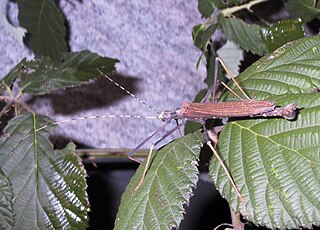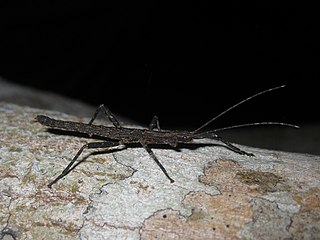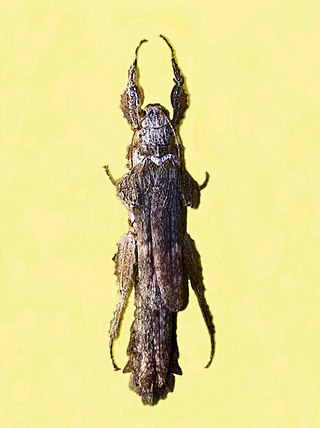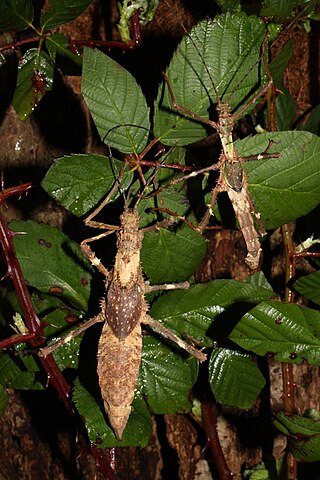
The Phasmatidae are a family of the stick insects. They belong to the superfamily Anareolatae of suborder Verophasmatodea.

Phobaeticus is a genus of Asian stick insects comprising over 25 species. The genus includes some of the world's longest insects.

Phyllium is the largest and most widespread genus of leaf insects in the family Phylliidae (Phasmatodea). They can be found in Sundaland, Philippine Islands, Wallacea, and Australasia.

Pseudophasmatidae is a family of stick insect, in the suborder Verophasmatodea, commonly called the "striped walkingsticks". An important identifying characteristic is its mesothorax, which is never more than three times as long as the prothorax.

Malacomorpha is a genus of striped walkingsticks in the family Pseudophasmatidae. There are about 15 described species in the genus Malacomorpha.

Prisopus is a genus of stick insects belonging to the family Prisopodidae. These stick insects are present in Central and South America, India and Malesia.

Pseudosermyle is a genus of walkingsticks in the family Diapheromeridae. There are more than 20 described species in Pseudosermyle.

Tafalisca is a genus of silent bush crickets in the family Gryllidae. Records for described species in Tafalisca are mostly from Central and South America.

The Clitumninae are a sub-family of stick insects in the family Phasmatidae found in Asia. The type genus Clitumnus is now considered a synonym of Ramulus.

Achrioptera is a genus of stick insects first described in 1861. It is one of two genera in the tribe Achriopterini, the other being Glawiana. Species in the genus Achrioptera occur in Africa, including Madagascar. Although they are brightly colored, members of Achrioptera are able to effectively mimic thorny twigs and sticks for camouflage.

Lonchodidae is a family of stick insects, with more than 150 genera and 1,000 described species.
Monticomorpha is a genus of striped walkingsticks in the family Pseudophasmatidae. There are 8 described species in Monticomorpha.

Phasmotaenia is a genus of phasmids belonging to the family Phasmatidae.

Heteropterygini is the only tribe within the subfamily of the Heteropteryginae. With 19 representatives described, this subfamily includes the fewest species of the three subfamilies, but includes the largest and most striking species of the family.

Haaniella is a genus of the Phasmatodea family Heteropterygidae from Southeast Asia.

Trachyaretaon is a genus of stick insects native to the Philippines.

Theramenes is a genus of medium-sized stick insects in the tribe Obrimini, which is native to the Philippines and to the Indonesian Talaud Islands.

The Cladomorphinae are a subfamily of stick insects in the family Phasmatidae. This taxon is particularly well represented in the Neotropical region, but records also exist for Madagascar, Java and the Maluku Islands.

Phyllium philippinicum is a species of leaf insect in the family Phylliidae. It is endemic to the Philippines.
Cnipsomorpha is a genus of Asian stick insects in the tribe Medaurini, erected by Hennemann, Conle, Zhang and Liu in 2008. Species have been recorded from: southern China and Vietnam.

















